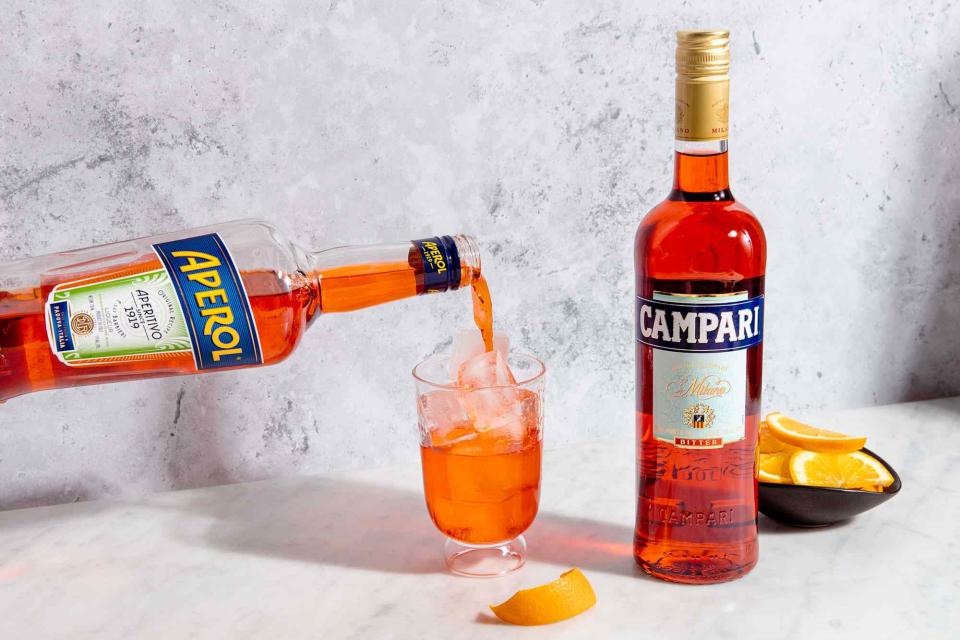What's the Difference Between Campari and Aperol?
Both are owned by the Campari Group.

Matt Taylor-Gross / Food Styling by Lucy Simon
If you walk through any Italian city or town around 5 PM or so, there’s a high chance you’ll see lots of people sitting on rickety folding chairs at tiny tables, while sipping red and orange drinks from massive, ice-filled goblets. The activity in question is called the aperitivo, and the drinks are spritzes — the orange drink made with Aperol, and the red with Campari.
Campari and Aperol have become integral ingredients on cocktail menus around the country, and are increasingly an essential part of any home bar arsenal. Nowadays, an Aperol Spritzes and Negronis are as well-known as Whiskey Sours or Martinis. While Aperol and Campari have a lot in common — they are Italian aperitifs, a category of bittersweet liqueurs made to be consumed before a meal, and are both owned by the Campari Group — understanding their differences is key to knowing how to use them. Read on for everything you need to know about Campari and Aperol.
What is Campari?
The key ingredient to cocktails like the Americano, Boulevardier, and TikTok’s favorite Negroni Sbagliato, Campari is beloved for its bright red color and bittersweet flavor. Campari is the best-known liqueur in a delicious category called red bitter liqueurs, which include other favorites like Select Aperitivo or Contratto. While all liqueurs are made with different ingredients, almost all start by infusing a neutral spirit or wine with a blend of natural ingredients like herbs, fruits, or flowers. For Campari, the exact details of its infusions are kept behind lock and key. “Campari was created in Milan in 1860 and the recipe has remained the same ever since,” writes Amelia Schwartz. “Although the exact formula is top secret, Campari’s flavor is rife with intense orange peel, rhubarb, and bark.” Historically Campari got its deep red hue from carmine dye, a red dye derived from cochineal insects, though it has been made with vegan dyes since 2006. At around 28% ABV (alcohol by volume) Campari is relatively high proof compared to other liqueurs and amaros.
What is Aperol?
Aperol is made much like Campari, but unlike its deep red counterpart, the ingredients for this orange-hued liqueur are slightly better-known. Aperol’s key ingredients include bitter rhubarb, vegetal gentian root, and cinchona, a tree bark which gives tonic water its characteristic bitterness. Alongside other fruits, flowers, and plants, the ingredients in Aperol combine into a citrusy aroma that has an herbal backbone. It tastes of orange zest with a bit of vanilla, and is much with a pleasant sweetness. “I like to refer to Aperol as ‘Campari with training wheels,” says Julie Reiner, expert bartender and partner of NYC’s Milady’s, Clover Club, and Leyenda. “Aperol is a great beginner Italian bitter as it is sweeter, and not quite as bitter as Campari.” Plus, its comparatively lower ABV allows the fruitiness to shine, at just 11% ABV, Aperol is a perfect fit for all-day sipping.
Related:Why Orange Liqueurs Should Be a Staple on Your Bar Cart
How to Use Campari
While Aperol and Campari have a lot of similarities, they can be used to achieve very different goals. Bartenders reach for Camapri when they want to add depth, body, bitterness, and a bit of sweetness to a cocktail. Simon Sebbah, beverage director of Grand Tour Hospitality, leans on Campari for richness and notes that “Campari brings a deeper herbal, orange peel flavor” to any drink it's added to. These characteristics make it a welcome companion to strong spirits like herbaceous gin and sweeter bourbon.
Campari’s intensity makes it susceptible to overwhelming other ingredients. “It can be a big bully in a cocktail,” says Reiner.” But its rigor also makes for interesting and inventive combinations. At Saint Theos in New York’s Greenwich Village, Sebbah pairs Campari with other strong flavors like spices, bitters, and even balsamic vinegar, to riff on the classic Americano cocktail. One of Reiner’s favorite signature cocktails, the Victory Garden (which she developed alongside Tom Macy at the Clover Club), pairs Campari with acidic tomato water. To Reiner’s delight, Campari added a much-needed bitter backbone to round out the drink.
How to Use Aperol
When you think of Aperol, the Aperol Spritz immediately comes to mind. The iconic spritz comes together with just three ingredients: Aperol, Prosecco, and club soda, and is often garnished with a generous wedge of orange. While an Aperol Spritz is undeniably refreshing, the combination shows off some of Aperol’s best attributes: the effervescence brings life to its citrusy aromas, while Prosecco’s sweetness pairs perfectly with the bitter notes.
Other fruity flavors pair well, too. “I find that grapefruit works perfectly [with Aperol] as well as watermelon for warmer days,” says Sebbah. Aperol’s sweetness can play well with sweet-and-sour fruits, and add bitter complexity to anything juicy. In the popular Paper Plane cocktail, Aperol provides a welcome hit of sweetness when mixed with Bourbon and a bittersweet liqueur.
Whether you’re building a spritzy highball or serving an austere stirred cocktail, Aperol and Campari add gorgeous color and plenty of flavor. In a pinch, take a cue from Reiner and pair Aperol and Campari with smoky mezcal for an easy and delicious cocktail.